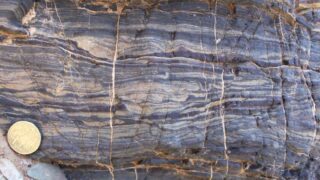A new way for life to survive Snowball Earth
Snowball Earth is the most extreme climate event Earth has ever seen. As opposed to ice sheets being restricted to continents only at high latitudes like Greenland and Antarctica today, the aptly named Snowball Earth would have engulfed the entire planet in thick ice.
When it was first proposed by Joseph Kirschvink of the California Institute of Technology and Paul Hoffman and his team at Harvard University, the extreme climatic event was an extremely contentious hypothesis. A page-turner written by Gabrielle Walker offers an inside look into the great debates among geologists in the late 1990s and early 2000s.
Now that the Snowball Earth hypothesis is generally accepted, it is easy to forget those early disagreements—but some scientists never forgot. A new discovery just published in Nature Communications finally reconciles what had remained, until now, two thorns in the side of the Snowball Earth hypothesis.
“One of the most fundamental challenges to Snowball was that life seems to have survived,” says Thomas Gernon, geologist at the University of Southampton and co-author of the study.
“So either Snowball didn’t happen, or life somehow avoided a bottleneck during the severe glaciation,” explains Gernon.
The other early challenge to the Snowball hypothesis came from the rocks themselves. There appeared to be too much variation in the layers of sediment deposited at that time.

During the Snowball, the frozen ocean would have been entirely cut off from the atmosphere. Without the normal exchange between the sea and air, many variations in climate that normally occur simply wouldn’t have.
“This was called the ‘sedimentary challenge’ to the Snowball hypothesis,” says Ross Mitchell, a previous Earth Dynamics Research Group member at Curtin University and now a professor of the Chinese Academy of Sciences in Beijing, China and the lead author.
“The highly variable rock layers appeared to show cycles that looked a lot like climate cycles associated with the advance and retreat of ice sheets,” explains Mitchell. Such variability was thought to be at odds with a static Snowball Earth entombing the whole ocean in ice.
The geologists decided to test the precise origin of the cycles in the sedimentary rocks. The rocks they targeted were “banded iron formation”, or BIF, in the Flinders Ranges National Park of South Australia.

BIF are unique sedimentary rocks with very thin layers of very iron-rich sediment. Although BIF had once been abundant on ancient Earth, they had essentially gone extinct until their reappearance during Snowball Earth about 700 million years ago.
“The iron comes from hydrothermal vents on the seafloor,” explains Gernon. Normally, the atmosphere oxidizes any iron immediately, so BIF typically doesn’t accumulate. But during the Snowball, with the ocean cut off from the air, iron was able to accumulate enough to form BIF.
The geologists discovered that the thin layers of BIF recorded evidence of the advance and retreat of ice sheets. In particular, the tempo of the cycles related to Earth’s orbital variations, known as Milankovitch cycles.
Earth’s orbit around the sun changes its shape, or eccentricity, and the tilt and wobble of Earth’s spin axis, known as obliquity and precession, also undergo cyclic changes. These astronomical cycles change the amount of incoming solar radiation that reaches Earth’s surface and, in doing so, they control climate.
“Even though Earth’s climate system behaved very differently during Snowball, Earth’s orbital variations would have been blissfully unaware and just continued to do their thing,” explains Mitchell.
Linda Hinnov, Professor at George Mason University who was not involved in the study, describes the discovery as “remarkable” and looks forward to testing one of the implications of the study that the global glaciation might have slowed Earth’s rate of rotation.
The ice age cycles that our ancestors endured would have also been operational during the Snowball.
“These ongoing orbital climate cycles caused the Snowball ice sheets to advance and retreat just like they do today,” says Gernon.
Now knowing that Snowball ice sheets were dynamic, not static, solves the two long-standing riddles. Both the sedimentary cycles and the survival of life were aided and abetted by Earth’s ongoing orbital variations.
Contact person: Dr Yebo Liu, Earth Dynamics Research Group, Curtin University.
Relevant publication:
Mitchell, R.N., Gernon, T.M., Cox, G.M., Nordsvan, A.R., Kirscher, U., Xuan, C., Liu, Y., Liu, X., He, X., 2021. Orbital forcing of ice sheets during snowball Earth. Nature Communications 12, 4187. https://doi.org/10.1038/s41467-021-24439-4
Related articles:
EurekAlert; ScienMag; Mirage News; Science Daily; IFLScience; Forbes
